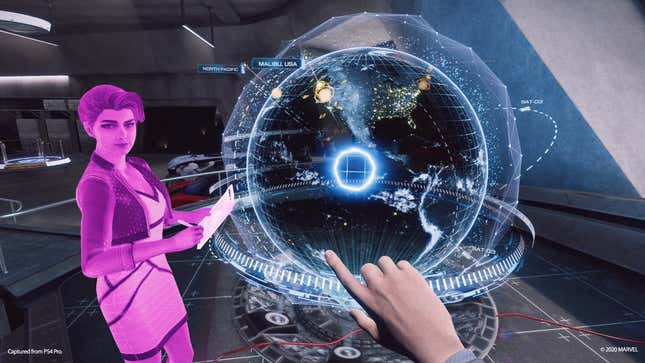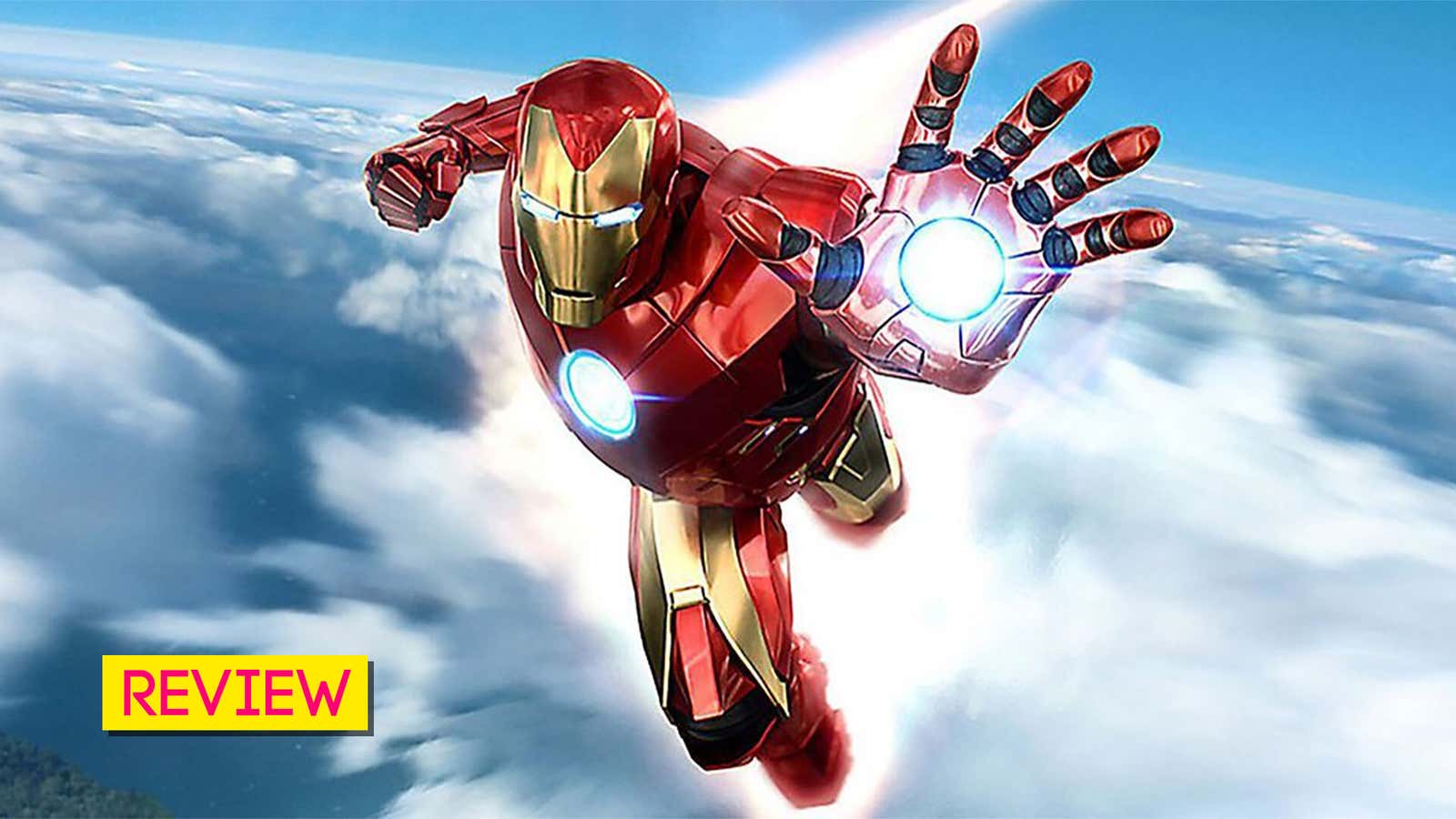Iron Man feels like a perfect fit for virtual reality. In the movies, Tony Stark’s advanced armor operates like VR, with a virtual screen projected inside his helmet. So when I put on my PSVR headset and started playing Iron Man VR I felt like that famous, armor-wearing superhero. Unfortunately, I didn’t have to just contend with super-villains. Technical problems ended up ruining much of my excitement and enjoyment.
Iron Man VR is, as the name implies, a virtual reality game that is built for the PSVR headset and motion controllers. In it, you play as Tony Stark, the famous billionaire who once ran a weapons company, but became a crime-fighting superhero who wears a powerful mech suit. Iron Man VR isn’t set in the Marvel Cinematic Universe, but is heavily inspired by those films. Tony Stark in both the game and the MCU has a large ego, is quick to spit out a joke and seems to be hiding a lot of guilt over his weapon selling past. His home in the game has a near-identical layout to the MCU version of Stark’s Malibu mansion. Even his suit not only looks like the MCU Iron man suit, but has the same sound effects and abilities. This is good. It helped me get lost in the world more, as it is a world I’m very familiar with.
The setup for this Iron Man tale is the sudden appearance of the teleporting villain Ghost, who begins causing havoc in Tony’s life. So Stark reactivates The Gunsmith, a dangerous AI built before he was a superhero, to help him fight back. Gunsmith is a super-advanced weapon-building and combat-training AI that uses a Tony Stark hologram as its avatar. While Gunsmith is effective and helpful, his brash and dangerous plans often cause more headaches and problems for Tony and his more peaceful suit-based AI, Friday. The family dynamics among the three are the core of the story.

Iron Man VR’s world and characters are its strongest and most consistently good elements. The interactions between these various characters are my favorite moments. They joke around, they tease each other, they get on each other’s nerves and they bicker or fight. The writing is sharp and often genuinely funny or interesting. I cared about these characters and what was going to happen to them. Even the villains become sympathetic characters who get more fleshed out by the end of the game. There are still some dumb video game moments, like the boss fight at the very end and a few plot points that made me roll my eyes with how obvious and silly they were, but by and large, playing Iron Man VR felt like being part of an MCU film. A B-tier MCU film, like a Thor or an Antman, but still a solid and fun superhero adventure.
Great character dynamics and solid writing aren’t why folks are going to play Iron Man VR. People want to be Iron Man. They want to fly around, blow stuff up and fight supervillains. And this is where Iron Man VR, sadly, falls apart more often than not.
Initially, I was impressed. It’s a bit gimmicky, but actually using the PS Motion controllers as Tony’s hand jets makes this feel unlike any other VR flying game I’ve played. To fly forward, you angle your hands behind your back. To stop, you can throw your hands in front of you, just like Iron Man does in the movies, and stop on a dime. It feels good. Turning is a bit less intuitive, as it is set to buttons on either controller, but I got used to it quickly and within a few minutes I was flying around like a pro. This is where I want to warn you that you need to have a strong VR stomach to play Iron Man VR. Whipping about at high speeds, while moving your head to look around— starting and stopping quickly—might cause some to feel motion sick. There are comfort settings you can turn on, like a setting that darkens the screen when you spin around fast, but this is still a fairly advanced VR game. I played with all of the comfort settings off and felt fine, but for less experienced or more sensitive VR players, be careful.
You don’t just fly in Iron Man VR, there’s also a bunch of combat. In theory, the combat controls seem smart. You hold your palms up to fire Iron Man’s famous laser blasts, and you point your wrist down to fire wrist-mounted auxiliary weapons, like grenades or missiles. You can also rocket punch enemies by holding a button and then punching. This may sound fine, but, in practice, it’s a bit of a mess.

There are a few major issues. For starters, the PSVR tracking doesn’t feel precise enough to always detect some of the motions needed during combat. Often I would try to shoot people with my missiles, but end up shooting lasers instead, or vice versa. Another problem is that some of the motions needed for combat aren’t comfortable. For example, flipping your wrist down to fire a missile feels cool, but then you have to arch your arm and wrist back up slightly so the PS Move controller can actually aim at your target. It doesn’t work well and it quickly hurt my wrists. Punches don’t always register, and button presses sometimes felt delayed, adding to an overall sense of inconsistency and frustration during combat.
However, I might have been able to ignore a lot of these problems if the game ran better during large combat sequences. Instead, the biggest problem Iron Man VR suffers from is poor performance. In a standard TV game, this isn’t always a deal-breaker. In a VR game, it is a huge problem. As I said before, I’m highly experienced with VR and have a strong stomach for all of the issues that can pop up, including huge FPS drops. And I’m thankful for that because I can easily see folks who aren’t as experienced getting headaches or becoming motion sick from the performance drops. I’m not talking about a few missed frames, but instead moments where the game almost becomes a slideshow. I played Iron Man VR on a PS4 Pro and still encountered these issues. It made the already finicky combat even more of a pain to deal with as I wasn’t just dealing with poor controls, but also annoying performance problems too.
And making all of this worse is just how much combat is in this game. You spend at least 75% of the game’s approximately eight hours of runtime fighting near-endless waves of drones and robots. The middle section Iron Man VR is a slog, filled with multiple levels where you fly into an area, get some story, and then fight a bunch of robots for 15 minutes. What’s frustrating is that the start and end of this game are so much stronger and more interesting than the slog of combat you deal with in the middle.

The beginning is filled with great character moments, a cool sequence with a plane (which is in the demo), and some simple, but cute “learning to fly” moments. The end section is also creative and different, forcing the player and Tony to figure out different ways to keep their suit powered up while trapped in a dark cave, being hunted the whole time. Instead of feeling all-powerful, you feel trapped in your suit as you desperately try to survive. These sections of the game make me wish I got something half as long, but with more of these types of sequences. Instead, Iron Man VR feels padded with endless combat and weapons in an attempt to make it feel more like a big, fully-featured video game.
Iron Man VR would have been better off being smaller, focusing the game on telling a story and using the suit in interesting and fresh ways. Instead, it focuses on being a big combat simulator that’s too clumsy to enjoy. Strong voice acting and writing can’t overcome all of Iron Man VR’s technical problems, which are bad enough that I would warn most players who haven’t tried much VR to stay away. For those with strong VR stomachs and a love of the MCU, there’s enough here that you might have a good time. But you might be better off just downloading the demo instead.






